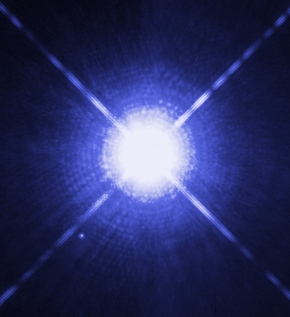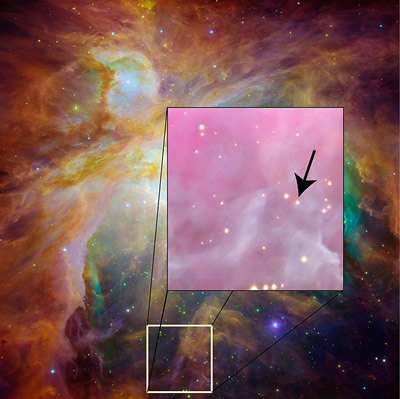Click on image for full size
Original Windows to the Universe artwork by Randy Russell, using a simulated view of Orion generated by Dennis Ward.
Magnitude - a measure of brightness
Astronomers use a special term to talk about the brightness of stars. The term is "magnitude". The magnitude scale was invented by the ancient Greeks around 150 B.C. The Greeks put the stars they could see into six groups. They put the brightest stars into group 1, and called them magnitude 1 stars. Stars that they could barely see were put into group 6. So, in the magnitude scale, bright stars have lower numbers.
A star that is one magnitude number lower than another star is about two-and-a-half times brighter. A magnitude 3 star is 2.5 times brighter than a magnitude 4 star. A magnitude 4 star is 2.5 times brighter than a magnitude 5 star.
A star that is five magnitude numbers lower than another star is exactly 100 times brighter. A magnitude 1 star is 100 times brighter than a magnitude 6 star.
Astronomers had to add some numbers to the magnitude scale since the times of the ancient Greeks. We now have lower, even negative, magnitudes for very bright objects like the Sun and Moon. We also have magnitudes higher than six for very dim stars that can be seen with telescopes.
The brightest star in the sky is Sirius. It has a magnitude of minus 1.4. The planet Mars is sometimes as bright as magnitude -2.8. Another planet, Venus, can shine as bright as magnitude -4.4. The Full Moon is a brilliant magnitude -12.6. And don't ever look at the Sun. At magnitude -26.8 the Sun's rays can damage your eyes!
Without a telescope, your eyes can just barely see magnitude 6 stars. The distant planet Pluto is magnitude 14, so you definitely need a telescope to see it. The best telescopes on Earth can spot stars with magnitudes between 25 and 27. The Hubble Space Telescope can sometimes "see" magnitude 30 stars.
There are two kinds of magnitudes for stars. One kind is apparent magnitude. The other is absolute magnitude. Apparent magnitude is how bright stars look to us in the sky from here on Earth. Remember, some stars are closer to us than other stars. A dim star that is nearby looks bright, while a very bright star that is far away looks dim. What if we could line up all of the stars the same distance away to do a fair test of their brightnesses? That is what absolute magnitude is all about.
Astronomers "pretend" to line up stars exactly 10 parsecs (about 32.6 light years) away from Earth. They then figure out how bright each star would look. They call that brightness the star's absolute magnitude. Our Sun is not an especially bright star. The Sun has an absolute magnitude of 4.83.















